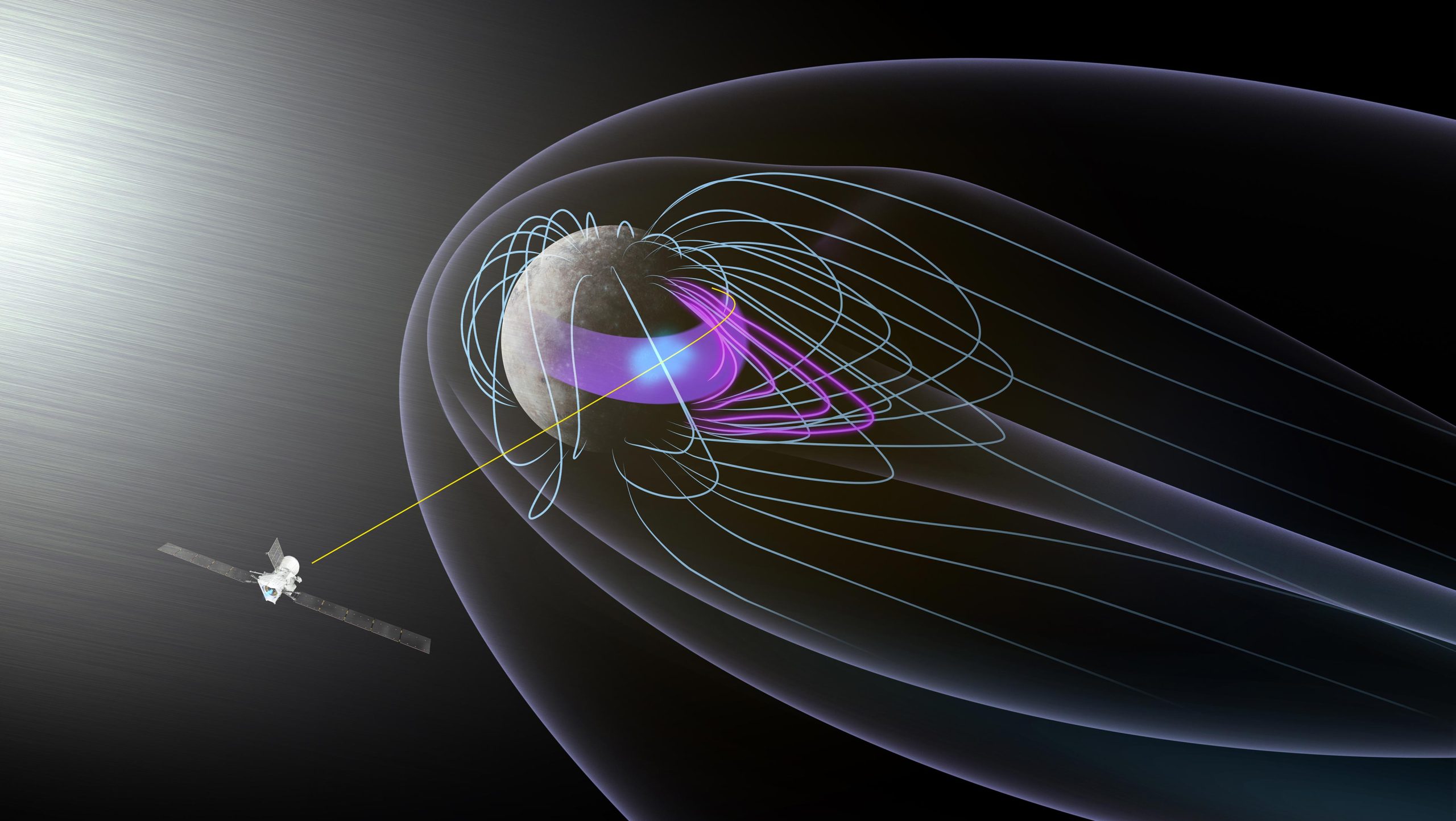
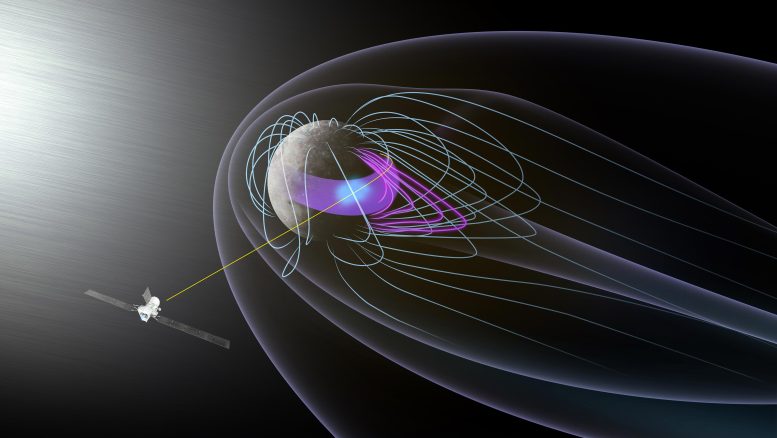
BepiColombo’s recent flyby of Mercury captured valuable data on its magnetic field and surrounding space plasma, hinting at complex magnetospheric features and the interactions between the planet’s surface and its thin atmosphere.
These initial findings are setting the stage for more comprehensive studies when the spacecraft enters Mercury’s orbit in 2026.
BepiColombo’s Mission
Like Earth, Mercury possesses a magnetic field, though it is one hundred times weaker at the planet’s surface. Despite its weakness, this magnetic field forms a protective bubble in space, known as a magnetosphere, which shields the planet from the relentless barrage of particles emitted by the Sun, known as the solar wind. Mercury’s proximity to the Sun intensifies these interactions, affecting both the magnetosphere and the planet’s surface more than those of Earth. Understanding the dynamics of this magnetic bubble and the characteristics of the particles it contains is a primary objective of BepiColombo’s mission.
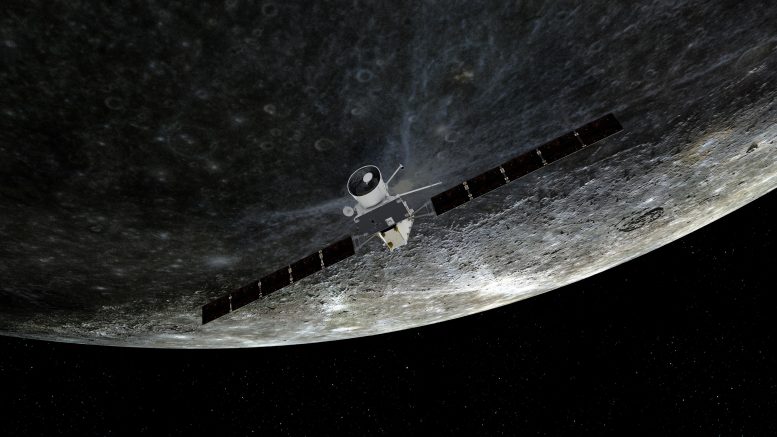
Preparing for Orbit Around Mercury
BepiColombo is set to arrive at Mercury in 2026 using flybys of Earth, Venus, and Mercury itself to adjust its speed and trajectory to allow it to be captured into orbit around the planet. The currently ‘stacked’ spacecraft will separate and deploy two science orbiters – the ESA-led Mercury Planetary Orbiter (MPO) and the JAXA-led Mercury Magnetospheric Orbiter (MMO, or Mio) – into complementary orbits to enable the essential dual-spacecraft measurements needed to paint a complete picture of Mercury’s dynamic environment.
As the spacecraft speeds past Mercury during the flybys, many of its science instruments are able to sneak a preview of the exciting science to come. Moreover, the flybys provide unique insights from regions around the planet that won’t be directly accessible from orbit.
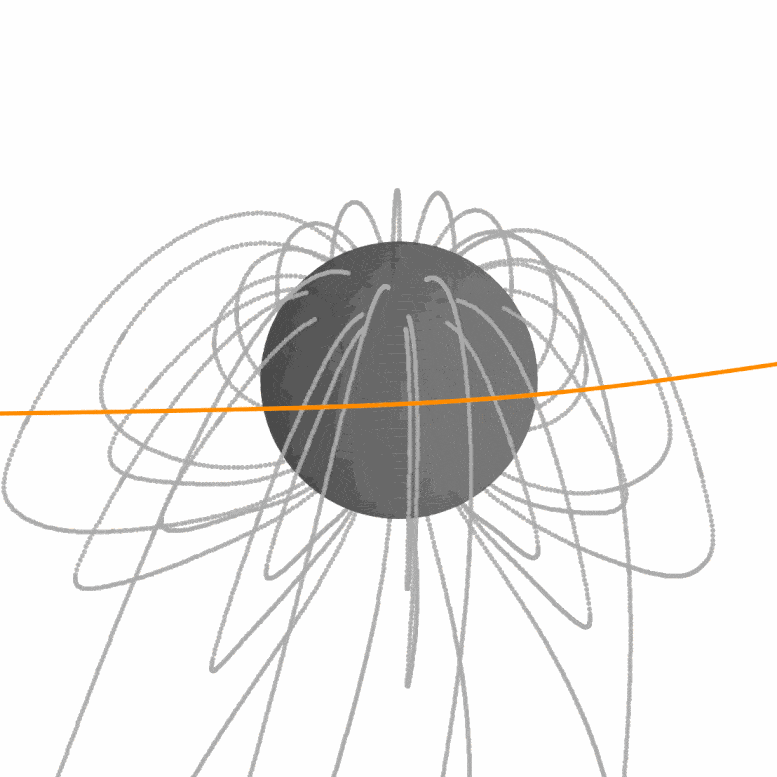
Mercury is shown with magnetic field lines compressed on the sunward side and streaming out into a tail on the nightside. The spacecraft trajectory is marked in orange; it approached from the dusk side of the planet and moved towards the dawn side, passing the planet’s surface as close as 235 km.
It only spent around 30 minutes inside the magnetosphere, but was able to glean a wealth of information about the magnetic, particle, and plasma environment along its path during this short period of time.
Credit: Sae Aizawa – LPP/CNRS
Detailed Observations from Flybys
Lina Hadid, a former ESA Research Fellow now at the Laboratoire de Physique des Plasmas at Paris Observatory, used the Mercury Plasma Particle Experiment (MPPE) suite of instruments active on Mio during the 19 June 2023 flyby, BepiColombo’s third of six Mercury gravity assists, to build up an impressive picture of the planet’s magnetic landscape in a very short period of time.
“These flybys are fast; we crossed Mercury’s magnetosphere in about 30 minutes, moving from dusk to dawn and at a closest approach of just 235 km above the planet’s surface,” she describes. “We sampled the type of particles, how hot they are, and how they move, enabling us to clearly plot the magnetic landscape during this brief period.”
Insights into Mercury’s Magnetosphere
Combining BepiColombo’s measurements with computer modeling to determine the origin of the detected particles based on their motion enabled Lina and her colleagues to sketch out the various features encountered in the magnetosphere.
“We saw expected structures like the ‘shock’ boundary between the free-flowing solar wind and the magnetosphere, and we also passed through the ‘horns’ flanking the plasma sheet, a region of hotter, denser electrically charged gas that streams out like a tail in the direction away from the Sun. But we also had some surprises.”
Lina is the lead co-investigator of MPPE and lead of one of its instruments, the Mass Spectrum Analyser. She worked on the Communications Physics paper presenting the results with former instrument lead Dominique Delcourt.
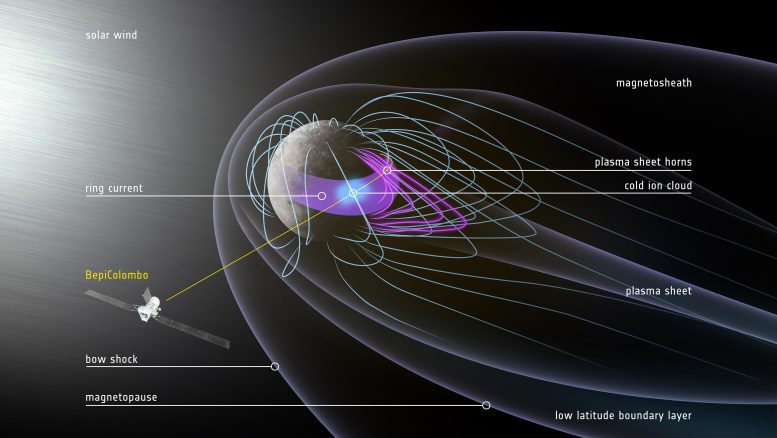
Mercury’s Complex Magnetosphere and Future Studies
“We detected a so-called low-latitude boundary layer defined by a region of turbulent plasma at the edge of the magnetosphere, and here we observed particles with a much wider range of energies than we’ve ever seen before at Mercury, in large thanks to the sensitivity of the Mass Spectrum Analyser designed especially for Mercury’s complex environment,” he says. “BepiColombo will be able to determine the ion composition of Mercury’s magnetosphere in greater detail than ever.”
“We also observed energetic hot ions near the equatorial plane and at low latitude trapped in the magnetosphere, and we think the only way to explain that is by a ring current, either a partial or complete ring, but this is an area that is much debated,” adds Lina.
A ring current is an electric current carried by charged particles trapped in the magnetosphere. Earth has a well-understood ring current located tens of thousands of kilometers from its surface. At Mercury, it is less clear how the particles can stay trapped within a few hundred kilometers of the planet, especially as the magnetosphere is squashed against the planet’s surface. This debate will likely be settled once MPO and Mio are collecting data full-time.
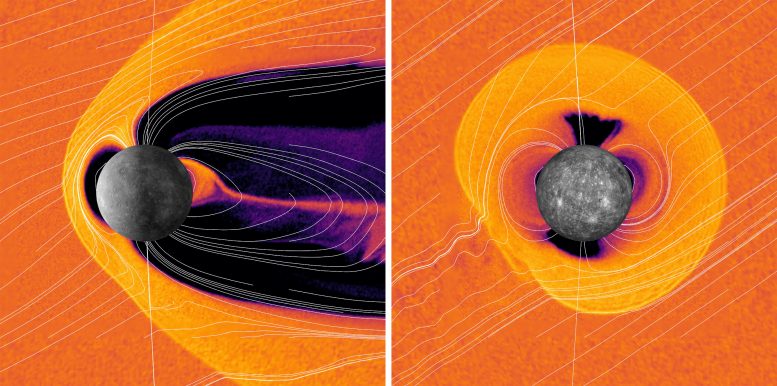
Mercury has a magnetic field that interacts with particles from the Sun (the ‘solar wind’). This creates Mercury’s magnetosphere – a bubble in space that is shaped like a windsock extending away from the Sun. This bubble is constantly changing in response to the solar wind.
This output from a simulation shows an expected case of Mercury’s magnetic environment under typical solar wind conditions. The left image shows a ‘side view’ where the Sun is out of frame to the left; the right image shows a ‘front view’ as if we are looking at Mercury from the direction of the Sun. The simulation is based on a model, it does not show real observations.
The colors indicate the density of charged particles around Mercury, with the highest density shown in yellow and the lowest density in purple/black. The white lines are magnetic field lines. (The near-vertical lines extending from the planet’s poles are numerical artifacts and should be ignored.)
The undisturbed solar wind appears dark orange. As the solar wind meets Mercury’s magnetic field, it is heated and deflected, creating a denser region of solar wind particles shown in yellow. Inside this dense layer, we see that the number of solar wind particles very quickly drops to almost zero, except for a stream extending from the equator.
Credit: Willi Exner – ESA & TU Braunschweig, Acknowledgments:
Based on the numerical model AIKEF (access thanks to Y. Narita (ITHP, TU Braunschweig) and D. Heyner (IGEP, TU Braunschweig))
Interaction of Spacecraft With Mercury’s Environment
Lina and her colleagues also observed the direct interaction of the spacecraft with the surrounding space plasma. When the spacecraft is heated by the Sun it cannot detect the colder, heavy ions because the spacecraft itself gets electrically charged and repels them. But as the spacecraft moves through the planet’s nightside shadow, the charging is different, and suddenly a sea of cold plasma ions become visible. For example, it detected ions of oxygen, sodium, and potassium, which were likely sent flying from the planet’s surface by micro-meteorite strikes or through interactions with the solar wind.
“It’s like we’re suddenly seeing the surface composition ‘exploded’ in 3D through the planet’s very thin atmosphere, known as its exosphere,” remarks Dominique. “It’s really exciting to start seeing the link between the planet’s surface and the plasma environment.”
Anticipations for Upcoming Discoveries
“In this rare dusk-to-dawn sweep through the large-scale structure of Mercury’s magnetosphere we’ve tasted the promise of future discoveries,” says Go Murakami JAXA’s BepiColombo project scientist.
“The observations emphasize the need for the two orbiters and their complementary instruments to tell us the full story and build up a complete picture of how the magnetic and plasma environment changes over time and in space,” adds Geraint Jones, ESA BepiColombo project scientist.
“We can’t wait to see how BepiColombo will impact our broader understanding of planetary magnetospheres.”
Preparing for Future Flybys
Meanwhile, scientists are already digging into the data snatched during last month’s fourth close Mercury flyby while flight controllers are readying for the final two back-to-back flybys slated for 1 December 2024 and 8 January 2025, respectively.
Reference: “Mercury’s plasma environment after BepiColombo’s third flyby” by Lina Z. Hadid, Dominique Delcourt, Yuki Harada, Mathias Rojo, Sae Aizawa, Yoshifumi Saito, Nicolas André, Austin N. Glass, Jim M. Raines, Shoichiro Yokota, Markus Fränz, Bruno Katra, Christophe Verdeil, Björn Fiethe, Francois Leblanc, Ronan Modolo, Dominique Fontaine, Norbert Krupp, Harald Krüger, Frédéric Leblanc, Henning Fischer, Jean-Jacques Berthelier, Jean-André Sauvaud, Go Murakami and Shoya Matsuda, 3 October 2024, Communications Physics.
DOI: 10.1038/s42005-024-01766-8
The results are based on measurements by the Mass Spectrum Analyser (MSA), Mercury Ion Analyser (MIA), and Mercury Electron Analyser (MEA), part of the Mercury Plasma Particle Experiment suite of instruments onboard the JAXA-led Mercury Magnetospheric Orbiter.
BepiColombo is a joint endeavor between ESA and the Japan Aerospace Exploration Agency (JAXA).